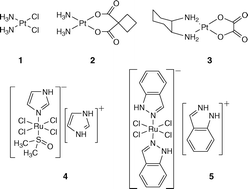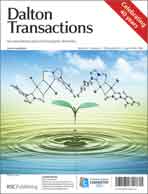During the last decade, our research group has prepared a number of metal dithiocarbamato derivatives of Pt, Pd and Au that were expected to resemble the main features of cisplatin together with higher activity, improved selectivity and bioavailability, and lower side-effects. Furthermore, we have already published the synthesis, characterization and in vitro cytotoxicity studies of novel ruthenium(III) dithiocarbamato complexes such as [RuL3] monomers (11) and α-[Ru2L5]Cl dimers (12) with five different dithiocarbamate ligands. As both the monomer and the dinuclear complexes have shown significant antitumor activity in different human tumor cell lines, we decided to widen the characterization studies and to analyse thoroughly their behavior in physiological-like medium by UV-visible and CD spectroscopy. In the present paper we report on the crystal structure of [Ru(DMDT)3], [Ru(PDT)3] and [Ru(ESDT)3] complexes and we determine the spin state of the paramagnetic Ru(III) by means of Evans' method. Then, we discuss in detail the UV-visible spectral data of the complexes in different medium. All the studied complexes are stable in dimethyl sulfoxide, and show low solubility in phosphate buffered saline solution, particularly the monomer species, even at low concentration, while increased solubility for both types of complexes have been found in the presence of bovine serum albumin (BSA). Moreover, no changes on the coordination sphere of the metal, as well as no direct interaction between the BSA protein and the complex have been identified by UV-visible spectroscopy. However, some conformational changes on the BSA structure, induced by the ruthenium(III) complexes have been confirmed by CD spectroscopy, indicating a probable secondary electrostatic interaction between the metal complex and the peptide. In addition, no significant interaction has been demonstrated with the components of Dulbecco's Modified Eagle's Medium, used for the in vitro assays.


 Please wait while we load your content...
Please wait while we load your content...